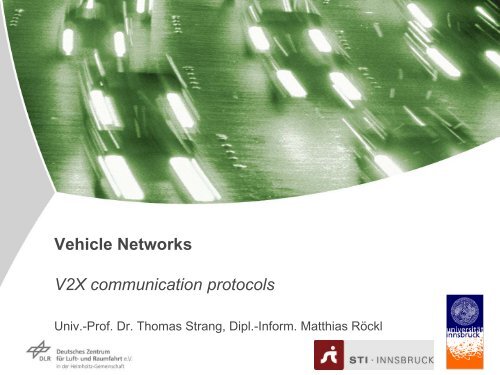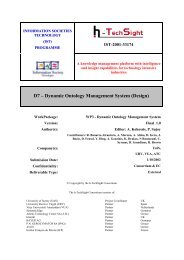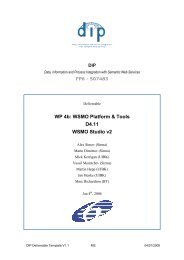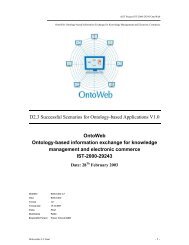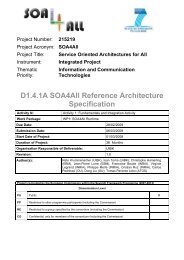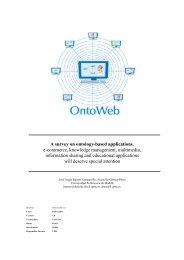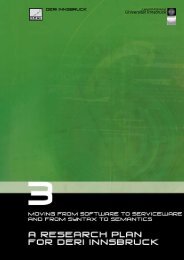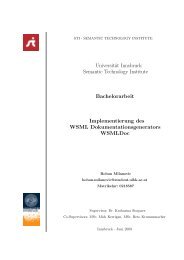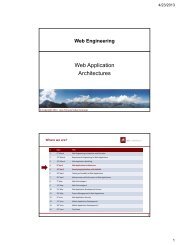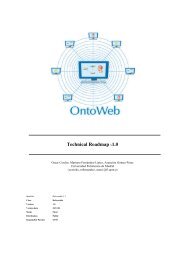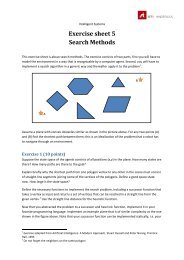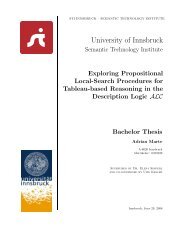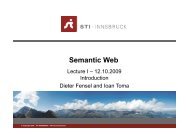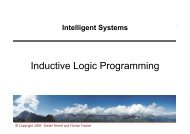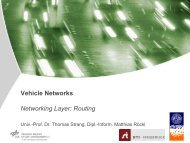Vehicle Networks V2X communication protocols - STI Innsbruck
Vehicle Networks V2X communication protocols - STI Innsbruck
Vehicle Networks V2X communication protocols - STI Innsbruck
Create successful ePaper yourself
Turn your PDF publications into a flip-book with our unique Google optimized e-Paper software.
<strong>Vehicle</strong> <strong>Networks</strong><br />
<strong>V2X</strong> <strong>communication</strong> <strong>protocols</strong><br />
Univ.-Prof. Dr. Thomas Strang, Dipl.-Inform. Matthias Röckl
Lecture <strong>Vehicle</strong> <strong>Networks</strong>, Thomas Strang and Matthias Röckl, WS 2008/2009<br />
Outline<br />
Wireless Access for Vehicular Environments (WAVE)<br />
IEEE 802.11p<br />
IEEE 1609.1-4<br />
SAE 2735<br />
Car-2-Car Communication Consortium & ETSI TC ITS
Lecture <strong>Vehicle</strong> <strong>Networks</strong>, Thomas Strang and Matthias Röckl, WS 2008/2009<br />
Wireless Access for Vehicular Environments<br />
Rationale<br />
What was the motivation behind a vehicle specific WLAN? What<br />
prevented the existing IEEE 802.11-family from being adopted as is?<br />
[Source: Daimler/C2C-CC]
Lecture <strong>Vehicle</strong> <strong>Networks</strong>, Thomas Strang and Matthias Röckl, WS 2008/2009<br />
Wireless Access for Vehicular Environments (WAVE)<br />
IEEE 802.11p + 1609.x + SAE 2735
Lecture <strong>Vehicle</strong> <strong>Networks</strong>, Thomas Strang and Matthias Röckl, WS 2008/2009<br />
Higher<br />
Layers<br />
Network<br />
Services<br />
Lower<br />
Layers<br />
Wireless Access for Vehicular Environments<br />
Overview<br />
SAE J2735<br />
IEEE 1609.1<br />
IEEE 1609.2<br />
IEEE 1609.3<br />
IEEE 1609.4<br />
IEEE 802.11p<br />
No. of<br />
layer<br />
ISO/OSI<br />
ref model<br />
1609.1 Resource Manager<br />
1609.2 Security Services<br />
1609.3 Networking Services<br />
1609.4 Multi-channel operations<br />
7 Application e.g. HTTP<br />
4 Transport TCP/UDP<br />
3 Network IPv6<br />
Data Plane Management Plane<br />
WAVE<br />
Application<br />
(Resource Manager)<br />
WSMP<br />
2b<br />
802.2 LLC<br />
2a<br />
Data Link<br />
WAVE MAC<br />
MAC<br />
Management<br />
1b<br />
1a<br />
Physical<br />
WAVE Physical Layer<br />
Convergence Protocol (PLCP)<br />
WAVE Physical Medium<br />
Dependent (PMD)<br />
PHY<br />
Management<br />
Management<br />
WAVE WAVE Station Station Management Entity Entity<br />
WSME WSME
Lecture <strong>Vehicle</strong> <strong>Networks</strong>, Thomas Strang and Matthias Röckl, WS 2008/2009<br />
IEEE 802.11p<br />
Requirements<br />
Changes in baseline 802.11 standards are required to:<br />
support longer ranges of operation (up to ~1000 meters),<br />
the high speed of the vehicles (up ~500 km/h relative velocities),<br />
the extreme multipath environment (many reflections with long<br />
delays (up to ~5 μs max excess)),<br />
the need for multiple overlapping<br />
ad-hoc networks to operate with<br />
extremely high quality of service,<br />
and<br />
the nature of the automotive<br />
applications (e.g. reliable<br />
broadcast) to be supported.<br />
Based on: IEEE 802.11p & Tan (2008):<br />
Measurement and Analysis of Wireless Channel<br />
Impairments in DSRC Vehicular Communications
Lecture <strong>Vehicle</strong> <strong>Networks</strong>, Thomas Strang and Matthias Röckl, WS 2008/2009<br />
IEEE 802.11p<br />
Overview<br />
IEEE 802.11p is based on:<br />
IEEE 802.11a PHY: OFDM modulation<br />
IEEE 802.11 MAC: CSMA/CA<br />
IEEE 802.11e MAC enhancement: message prioritization
Lecture <strong>Vehicle</strong> <strong>Networks</strong>, Thomas Strang and Matthias Röckl, WS 2008/2009<br />
IEEE 802.11p<br />
Communication entities<br />
Communication between:<br />
roadside units and mobile radio units (<strong>Vehicle</strong>-2-Infrastructure),<br />
mobile units (<strong>Vehicle</strong>-2-<strong>Vehicle</strong>), or<br />
portable units and mobile units (<strong>Vehicle</strong>-2-Pedestrian)<br />
Infrastructure:<br />
Roadside Units (RSUs)<br />
Gantries (e.g. tolling gantries)<br />
Poles, traffic lights, etc.<br />
Mobile/Portable equipment:<br />
On-board Unit (OBU)<br />
Denso DSRC platform<br />
Based on IEEE 802.11p
Lecture <strong>Vehicle</strong> <strong>Networks</strong>, Thomas Strang and Matthias Röckl, WS 2008/2009<br />
IEEE 802.11p<br />
<strong>Vehicle</strong>-2-Pedestrian<br />
[Source:<br />
www.OKI.com]
Lecture <strong>Vehicle</strong> <strong>Networks</strong>, Thomas Strang and Matthias Röckl, WS 2008/2009<br />
IEEE 802.11p<br />
Pedestrian?<br />
IEEE 802.11p DSRC module<br />
GPS receiver<br />
Regular GSM phone
Lecture <strong>Vehicle</strong> <strong>Networks</strong>, Thomas Strang and Matthias Röckl, WS 2008/2009<br />
<strong>V2X</strong> frequency bands
Lecture <strong>Vehicle</strong> <strong>Networks</strong>, Thomas Strang and Matthias Röckl, WS 2008/2009<br />
IEEE 802.11p<br />
Frequency band<br />
U.S. FCC allocated 75 MHz band in 1999 for ITS<br />
5.825<br />
Power Limit<br />
Power Limit<br />
Power Limit<br />
5.830<br />
5.835<br />
5.845<br />
5.850<br />
Shared Public Safety/Private Dedicated Public Safety<br />
Control Medium Rng<br />
Service<br />
Short Rng<br />
Service<br />
High<br />
Availability<br />
Intersections<br />
5.855<br />
5.860<br />
33 dBm<br />
5.865<br />
5.870<br />
5.875<br />
44.8 dBm<br />
5.880<br />
5.885<br />
Uplink<br />
Downlink<br />
Public<br />
Safety<br />
Veh-Veh<br />
Public<br />
Safety/<br />
Private<br />
Public<br />
Safety/<br />
Private<br />
Public<br />
Control<br />
Safety/<br />
Channel<br />
Private<br />
Public<br />
Safety/<br />
Private<br />
Public Safety<br />
Intersections<br />
Ch 172 Ch 174 Ch 176 Ch 178 Ch 180 Ch 182 Ch 184<br />
5.890<br />
5.895<br />
5.900<br />
5.905<br />
40 dBm<br />
23 dBm<br />
Based on B. Cash (2008): North American 5.9 GHz DSRC Operational Concept / Band Plan<br />
5.910<br />
5.915<br />
5.920<br />
5.925
Lecture <strong>Vehicle</strong> <strong>Networks</strong>, Thomas Strang and Matthias Röckl, WS 2008/2009<br />
IEEE 802.11p<br />
Multi-channel<br />
Control Channel (CCH):<br />
Broadcast <strong>communication</strong><br />
Dedicated to short, high-priority, data and management frames:<br />
Safety-critical <strong>communication</strong> with low latencies<br />
Initialization of two-way <strong>communication</strong> on SCH<br />
Service Channel (SCH):<br />
Two-way <strong>communication</strong> between RSU and OBU or between<br />
OBUs<br />
For specific applications, e.g. tolling, internet access<br />
Different kinds of applications can be executed in parallel on<br />
different service channels<br />
Requires the setup of a WAVE Basic Service Set<br />
(WBSS – “Ad-hoc group”) prior to usage of the SCH
Lecture <strong>Vehicle</strong> <strong>Networks</strong>, Thomas Strang and Matthias Röckl, WS 2008/2009<br />
IEEE 802.11p<br />
Operation modes<br />
Without WAVE Basic<br />
Service Set (WBSS)<br />
Safety-critical, low latency<br />
messages and control messages<br />
Mainly broadcast<br />
Only on CCH<br />
Operation modes<br />
With WAVE Basic<br />
Service Set (WBSS)<br />
Two-way transactions (e.g.<br />
tolling, internet access)<br />
Required to use a SCH<br />
Requires initiation on CCH<br />
In contrast to the Independent<br />
Basic Service Set (IBSS),<br />
WBSS does not require<br />
authentication and association<br />
procedures
Lecture <strong>Vehicle</strong> <strong>Networks</strong>, Thomas Strang and Matthias Röckl, WS 2008/2009<br />
IEEE 802.11p<br />
PHY<br />
OFDM-based modulation similar to<br />
IEEE 802.11a<br />
Halved channel bandwidth of IEEE<br />
802.11a: � 10 MHz channels<br />
� half data rate: 3-27 Mbps<br />
� doubled symbol duration: 8.0 μs<br />
10 MHz<br />
156.25 kHz
Lecture <strong>Vehicle</strong> <strong>Networks</strong>, Thomas Strang and Matthias Röckl, WS 2008/2009<br />
IEEE 802.11p<br />
PHY: Comparison to IEEE 802.11a<br />
Data rate 6, 9, 12, 18, 24,<br />
36, 48, 54 Mbps<br />
Modulation BPSK OFDM<br />
QPSK OFDM<br />
16-QAM OFDM<br />
64-QAM OFDM<br />
Error Correction Coding Convolutional<br />
Coding with K=7<br />
IEEE 802.11a IEEE 802.11p<br />
3, 4.5, 6, 9, 12,<br />
18, 24, 27 Mbps<br />
BPSK OFDM<br />
QPSK OFDM<br />
16-QAM OFDM<br />
64-QAM OFDM<br />
Convolutional<br />
Coding with K=7<br />
Coding Rate 1/2, 2/3, 3/4 1/2, 2/3, 3/4<br />
# of subcarriers 52 net 52 net<br />
OFDM Symbol Duration 4.0 μs 8.0 μs<br />
Guard Period 0.8 μs 1.6 μs<br />
Occupied bandwidth 20 MHz 10 MHz<br />
Frequency 5 GHz ISM band 5.850-5.925 GHz<br />
Longer guard period<br />
� Less Inter-symbol Interference<br />
� Better resistance against multipath error<br />
Re-order of sub-carriers<br />
� Better multipath mitigation<br />
Dedicated frequency band<br />
� Less Co-Channel Interference
Lecture <strong>Vehicle</strong> <strong>Networks</strong>, Thomas Strang and Matthias Röckl, WS 2008/2009<br />
IEEE 802.11p<br />
MAC<br />
Based on Distributed Control Function (DCF) with CSMA/CA<br />
MAC-level acknowledgements for unicast <strong>communication</strong>,<br />
but no acknowledgements for broadcast <strong>communication</strong><br />
� unreliable broadcast <strong>communication</strong><br />
RTS/CTS is only used on SCH<br />
Because of higher range, slot time and SIFS should be longer<br />
Addressing:<br />
RSUs have a fixed 48-bit MAC address<br />
OBUs generate a random MAC address<br />
upon start-up of the device<br />
If a MAC address collision occurs the<br />
OBU automatically changes its MAC<br />
address<br />
Prioritization based on IEEE 802.11e EDCA<br />
(Enhanced Distributed Channel Access),<br />
defined in IEEE 1609.4<br />
IEEE<br />
802.11a<br />
IEEE<br />
802.11p<br />
Slot time 9 μs 13 μs<br />
SIFS time 16 μs 32 μs<br />
CW min 15 15<br />
CW max 1023 1023<br />
SIFS – Short Inter-Frame Space
Lecture <strong>Vehicle</strong> <strong>Networks</strong>, Thomas Strang and Matthias Röckl, WS 2008/2009<br />
IEEE 1609.4<br />
Extension for multi-channel coordination<br />
IEEE 1609.4 is a functional extension to IEEE 802.11e MAC to enable<br />
multi-channel coordination<br />
Functions:<br />
Channel routing<br />
Data buffers (queues)<br />
Prioritization<br />
Channel coordination
Lecture <strong>Vehicle</strong> <strong>Networks</strong>, Thomas Strang and Matthias Röckl, WS 2008/2009<br />
IEEE 1609.4<br />
Channel Coordination<br />
Each Universal Time Coordinated (UTC) second is split<br />
into 10 Sync Intervals<br />
Every Sync Interval is composed of alternating:<br />
CCH Intervals: Every node monitors the CCH and<br />
SCH Intervals: Nodes can monitor one of the SCHs<br />
All WAVE devices have to monitor the CCH during the CCH Interval<br />
During the SCH Interval nodes may switch to a SCH (RX or TX)<br />
At the start of each UTC second the first Sync Interval begins<br />
Synchronization is performed via GPS
Lecture <strong>Vehicle</strong> <strong>Networks</strong>, Thomas Strang and Matthias Röckl, WS 2008/2009<br />
IEEE 1609.3<br />
Networking Services<br />
IP-based <strong>communication</strong>:<br />
IPv6-based with optional:<br />
Mobile IPv6 (MIPv6) and<br />
Network Mobility (NEMO)<br />
enhancements<br />
UDP or TCP on transport layer<br />
Transmission on SCH only<br />
Non-IP-based <strong>communication</strong>:<br />
Based on<br />
WAVE Short Message Protocol<br />
(WSMP)<br />
Transmission on CCH or SCH<br />
No.<br />
of<br />
layer<br />
Data Plane<br />
4<br />
3<br />
TCP/UDP<br />
IPv6<br />
WSMP<br />
2b 802.2 LLC<br />
2a WAVE MAC<br />
1b WAVE PLCP<br />
1a WAVE PMD<br />
SCH<br />
CCH/SCH
Lecture <strong>Vehicle</strong> <strong>Networks</strong>, Thomas Strang and Matthias Röckl, WS 2008/2009<br />
IEEE 1609.3<br />
WAVE Short Message Protocol (WSMP)<br />
Networking protocol specifically designed for <strong>V2X</strong> <strong>communication</strong>s<br />
WAVE Short Message (WSM)<br />
structure:<br />
WSMP can use CCH and SCH<br />
During the SCH Interval low priority messages can be transmitted on<br />
CCH for stations that do not switch to a SCH, high priority frames and<br />
WAVE Announcement frames shall be transmitted during the CCH<br />
Interval<br />
In order to access a SCH, the nodes have to be member of the WBSS<br />
WBSS roles:<br />
Provider: Initiates a WBSS by sending a WAVE Announcement<br />
User: Joins a WBSS based on the receipt of the WAVE<br />
Announcement
Lecture <strong>Vehicle</strong> <strong>Networks</strong>, Thomas Strang and Matthias Röckl, WS 2008/2009<br />
SAE J2735<br />
Message Dispatcher<br />
Implementation specific common<br />
Implementation specific<br />
Based on: Robinson et al. (2006): Efficient Coordination and<br />
Transmission of Data for Cooperative Vehicular Safety Applications
Lecture <strong>Vehicle</strong> <strong>Networks</strong>, Thomas Strang and Matthias Röckl, WS 2008/2009<br />
SAE J2735<br />
Basic message set definition<br />
SAE J2735: Dedicated Short Range Communication (DSRC) Message<br />
Set Dictionary<br />
ASN.1 representation of message structures<br />
Hierarchical definition of messages and substructures<br />
Basic message set is not so basic any more, i.e. comprehensive:<br />
16 different message frames, which use<br />
54 different data frames, which are parametrized through<br />
162 different data elements
Lecture <strong>Vehicle</strong> <strong>Networks</strong>, Thomas Strang and Matthias Röckl, WS 2008/2009<br />
Car-2-Car Communication Consortium<br />
(C2C-CC)<br />
&<br />
ETSI TC ITS
Lecture <strong>Vehicle</strong> <strong>Networks</strong>, Thomas Strang and Matthias Röckl, WS 2008/2009<br />
Car-to-Car Communication Consortium<br />
Partners<br />
Partners<br />
Associate<br />
Members<br />
Dev.<br />
Members
Lecture <strong>Vehicle</strong> <strong>Networks</strong>, Thomas Strang and Matthias Röckl, WS 2008/2009<br />
Car-2-Car Communication Consortium<br />
Protocol stack
Lecture <strong>Vehicle</strong> <strong>Networks</strong>, Thomas Strang and Matthias Röckl, WS 2008/2009<br />
Objectives<br />
Car-to-Car Communication Consortium<br />
Objectives of the First Demonstration (October 2008)<br />
Demonstrate the<br />
functionality of CAR 2 CAR Communication Consortium system<br />
with 5 selected use cases<br />
Warning of road works<br />
Emergency vehicle<br />
Broken down vehicle<br />
Motorcycle use case / intersection scenario<br />
Situation Monitor<br />
interoperability between different <strong>communication</strong> platforms<br />
9 vehicle manufacturers<br />
(Opel, BMW, Daimler, Volvo, Renault, Fiat,<br />
Volkswagen, Audi, Honda, …)<br />
4 <strong>communication</strong> supplies<br />
(NEC, Hitachi / Renesas, Delphi, Denso)<br />
1 after market supplier<br />
(Alpine)<br />
impact of vehicle-to-x <strong>communication</strong><br />
[Slide by M. Kranz]
Lecture <strong>Vehicle</strong> <strong>Networks</strong>, Thomas Strang and Matthias Röckl, WS 2008/2009<br />
Demonstration self-restricted<br />
to just two message types: CAM and DEN<br />
Demonstration of technology although not<br />
fully specified yet. Thus, as compromise,<br />
mask layer 3..6 (i.e. APP on top of LLC)<br />
Cooperative Awareness Message (CAM)<br />
Type of <strong>Vehicle</strong>, Position, Speed, Heading<br />
Broadcasted by all vehicles with 1 Hz<br />
Decentralized Environment Notification Message (DEN)<br />
Type of Event, Region of Event<br />
Broadcasted by RSU or <strong>Vehicle</strong><br />
No. of<br />
layer<br />
7<br />
6<br />
5<br />
4<br />
3<br />
Data Plane<br />
Demo-APP<br />
2b 802.2 LLC<br />
2a WAVE MAC<br />
1b WAVE PLCP<br />
1a WAVE PMD
Lecture <strong>Vehicle</strong> <strong>Networks</strong>, Thomas Strang and Matthias Röckl, WS 2008/2009<br />
Use Case 1<br />
Use Cases – Warning of Road Works<br />
Construction sites and temporary maintenance working areas are<br />
accident black spots:<br />
Changed traffic flow<br />
More traffic signs<br />
Lane width changes, lane merging, “stress”, and other factors<br />
The CAR 2 CAR system informs the driver on the details of the<br />
situation well before entering the potentially dangerous area<br />
Geographic extent and affected area<br />
Duration of road works<br />
Reason of road works<br />
…<br />
[Slide by M. Kranz]
Lecture <strong>Vehicle</strong> <strong>Networks</strong>, Thomas Strang and Matthias Röckl, WS 2008/2009<br />
Use Case 2<br />
Use Cases – Emergency <strong>Vehicle</strong> (EV)<br />
When it comes to situations affecting the safety of lives every minute<br />
and every second is crucial. Road users are obliged to make way for<br />
Emergency vehicles (EVs) like ambulances or police cars. Potential<br />
problems are:<br />
Source of siren<br />
Crossing emergency vehicles at “green” lights<br />
Destination of emergency vehicle<br />
The CAR 2 CAR system informs the driver<br />
about the location of the source of the siren<br />
where the emergency vehicle is heading<br />
on what lane the emergency vehicle will be overtaking<br />
only if the emergency vehicle is expected to cross his route<br />
[Slide by M. Kranz]
Lecture <strong>Vehicle</strong> <strong>Networks</strong>, Thomas Strang and Matthias Röckl, WS 2008/2009<br />
Use Case 3<br />
Use Cases – Broken Down <strong>Vehicle</strong> /<br />
Post Crash Warning<br />
Accidents and break downs are dangerous for any involved or<br />
assisting person as well as for approaching vehicles. Problems are:<br />
Line of sight obstruction, e.g. behind a curve or hill top or due to<br />
weather conditions<br />
Timely warning of affected traffic participants<br />
If a vehicle detects a incident based on emergency flasher status,<br />
crash sensors, or onboard diagnosis, it can use the CAR 2 CAR<br />
system to<br />
inform about the type and location of the incident<br />
raise awareness and alertness to the traffic situation<br />
act as “modern warning vest”<br />
[Slide by M. Kranz]
Lecture <strong>Vehicle</strong> <strong>Networks</strong>, Thomas Strang and Matthias Röckl, WS 2008/2009<br />
Use Case 4<br />
Use Cases – Motorcycle Warning /<br />
Intersection Assistance<br />
European In-depth motorcycle accident analyses highlights that<br />
human error, and more specifically not seeing the motorcycle coming<br />
or misinterpreting distance and speed is the primary cause of<br />
accidents involving motorcycles. Reasons are:<br />
Motorcycles have a smaller silhouette and are easier to “overlook”<br />
Motorcycles do not have a crumble zone<br />
The CAR 2 CAR system informs the drivers of the involved vehicles<br />
about the presence of other traffic participants<br />
by sending a respective warning message if a crash is predicted<br />
[Slide by M. Kranz]
Lecture <strong>Vehicle</strong> <strong>Networks</strong>, Thomas Strang and Matthias Röckl, WS 2008/2009<br />
Car-2-Car Communication Consortium<br />
Focus and on-going discussions<br />
Focus on vehicle-to-vehicle <strong>communication</strong> (well, focus get’s blurred<br />
more and more …)<br />
Multi-hop<br />
Geo-based addressing and routing<br />
Dual-receiver concept:<br />
Parallel reception on 2 channels<br />
Optional: dual-transmitter<br />
Simulation scenarios and scalability<br />
…<br />
If you are looking<br />
for an interesting<br />
thesis topic in this<br />
area, contact me!
Lecture <strong>Vehicle</strong> <strong>Networks</strong>, Thomas Strang and Matthias Röckl, WS 2008/2009<br />
Car-2-Car Communication Consortium / ETSI TC ITS<br />
Relationship<br />
European industrial development of <strong>V2X</strong> <strong>communication</strong> by C2C-CC<br />
Created the European derivative of IEEE 802.11p<br />
Standardization by the European Tele<strong>communication</strong>s Standards<br />
Institute (ETSI) Technical Committee ITS<br />
ETSI is the relevant European standardization body for<br />
tele<strong>communication</strong> <strong>protocols</strong><br />
Transferring the standardization process from C2C-CC to ETSI TC ITS<br />
C2C-CC WGs act as preparatory platforms & discussion fora for ETSI<br />
TC ITS WGs.<br />
One critical issue with the transfer of standardization to ETSI are the<br />
ETSI voting rules, which may add a strong bias to the whole process


